Let’s make some charts! In general, both nominal (not adjusted for inflation) personal income and nominal household net worth have exhibited an upward trend over the 20-year period ending in the first quarter of 2008. Both series, however, may be affected by macroeconomic developments. So, let’s view the trends in these data and see what economic events have affected their expansion paths, including the factors you have asked about, the recent housing slump, and weak economic growth.
Measuring personal income and household net worth
Before going any further, let’s make sure we are clear on definitions.
Personal income is income received by persons from all sources. To understand the dynamics of personal income, let’s examine its components, as the behavior of those components helps explain its movement over time. Table 1 shows that personal income in the fourth quarter of 2007 was $11.9 trillion. Wages and compensation constitute the bulk of personal income (about two-thirds), with proprietor’s income, dividends, interest, and government transfer payments being other key personal income components. These data are published by the Bureau of Economic Analysis as part of the release of gross domestic product (GDP) data.
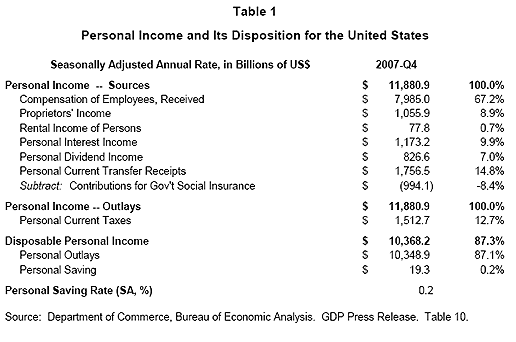
Household net worth is the difference between household assets and liabilities. Table 2 shows net worth and its components. The data are as of the fourth quarter of 2007 and are taken from the Federal Reserve Board’s Flow of Funds Release that provides quarterly estimates of the household sector balance sheet. To find net worth, we add the tangible and financial assets of the household sector (these data also include nonprofit organizations) together to get gross assets ($72.1 trillion in total). Note that key asset categories of households include owner-occupied real estate, pension fund reserves, corporate stocks (equity shares at market value held directly and mutual fund shares), and deposits. Next, we subtract out total liabilities of the household sector ($14.5 trillion) to calculate net worth. Fourth quarter 2007 net worth for the U.S. was $57.6 trillion.
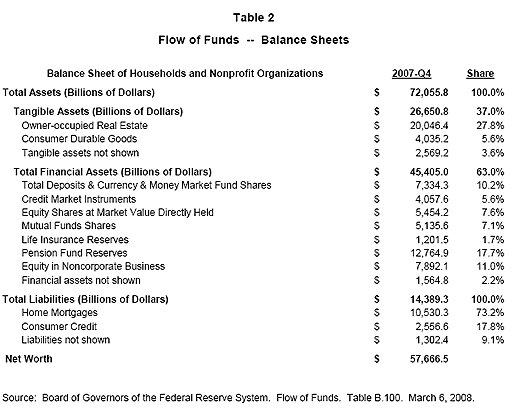
Finally, it is important to point out that we are discussing two different economic concepts when we examine personal income and net worth. Personal income is a flow measure. It measures how much personal income was earned over a period of time at an annual rate. In contrast, net worth is a stock measure. It is a snapshot; it measures the net worth of households at a point in time.
Charting the trends in personal income and net worth
By showing both the quarterly flow of personal income and the quarterly stock of net worth of households (including nonprofit organizations) in Figure 1, we can see how they have followed similar upward long-term trends but occasionally diverged from those trends in the short-run.
Figure 1. Trends in Personal Income and Household Net Worth
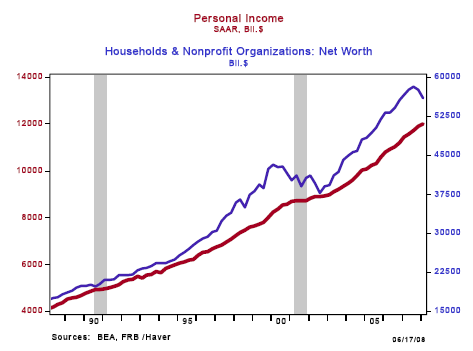
The chart shows the period from early 1988 to the first quarter of 2008. The thick red line in Figure 1 represents the flow of nominal personal income (measured on the left axis). The thin blue line represents the stock of household net worth (measured on the right axis). To identify periods when the economy was contracting, the gray bars in the chart show periods of recession as defined by the National Bureau of Economic Research (for more information on how recessions are defined, check out the following June 2003 Dr. Econ discussion).
The chart indicates that nominal personal income expanded over nearly the entire period shown. Moreover, you can see from the chart that personal income is less volatile than net worth.
Including some measure of long-term trends for both series in Figures 2 and 3 should facilitate our discussion. Figure 2 shows personal income (thick blue line) and one possible measure of its long-term trend (thin red line).1 Figure 3 does the same for net worth (thick blue line shows net worth and thin red line shows the long-term trend, measured the same way as for personal income).
You can see in Figure 2 that personal income has recorded much less variation around its long-term trend than net worth (this is just another way to point out that personal income shows less volatility). The short-run deviations of personal income from trend show up most obviously around the 2001 recession, when personal income moved above trend before the recession, then fell slightly below after the recession. This is not a coincidence: the NBER uses real personal income (inflation adjusted) less transfer payments as one of the key monthly economic indicators to help define periods of recession in the economy.
Figure 2. Deviations from Trends in Personal Income
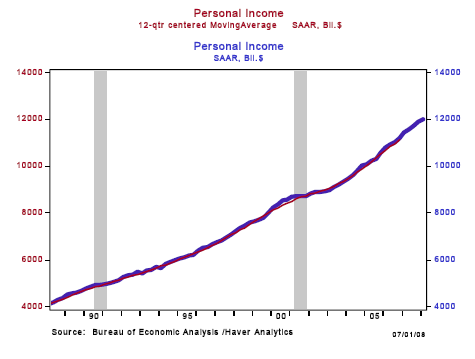
In contrast, net worth recorded periods of larger expansion and contraction around a general upward trend, as demonstrated in Figure 3. From 1994 to 1999 the dramatic rise in the stock market added over $8 trillion to the net worth of households that owned stocks. (This includes both equity shares at market value directly held and mutual fund shares; the latter are included since on average, over the past 10 years almost 69 percent of mutual fund shares were held as corporate equities.) The increase in stock values drove up net worth well above trend growth.
Figure 3. Deviations from Trends in Household Net Worth
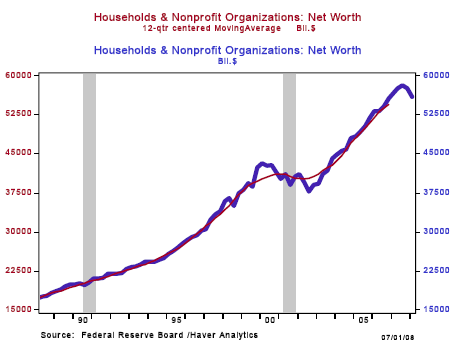
When the dot-com bubble burst, stock values fell sharply, subtracting nearly $6 trillion from net worth from households between 1999 and 2002; the decline was of large enough magnitude to cause an overall reduction in net worth during the period. Note, however, that housing wealth was continuing to increase during that period. From 2002 to 2006, net worth climbed rapidly; during this period households added over $6 trillion in net worth from appreciation in their real estate assets, and nearly $4 trillion in stock appreciation.
However, by the end of 2007, as the economy was slowing and the housing market contracting, net worth started to fall. While we will have to wait for future data to see if this trend continues, at the time this response is written the decline is being driven by two factors. First, the Flow of Funds data published by the Federal Reserve since the early 1950s recorded their first ever decline in the value of owner-occupied real estate, while at the same time the market value of households’ equity shares and mutual fund shares were falling.
Growth rates of personal income and net worth
Another way to examine the behavior of personal income and net worth is to compare their growth rates. Figure 4 compares quarterly year-over-year-percent changes over the same 20-year period shown in Figures 1-3. Both series shown in the figure tend to expand at an annual rate in excess of 5 percent. However, the growth rate of personal income has showed much less variation over time than the growth rate for net worth.2 While the growth rate of personal income slowed on a year-over-year basis before, during, and immediately after the 1990-1991 and 2001 recessions, it remained positive throughout the entire period.
In contrast, on at least three occasions during this period, key asset prices fell enough to cause net worth to actually decline from a year earlier. Unlike these episodes when the decline in net worth was driven by a fall in financial wealth, the current decline in net worth is driven by declines in both housing and financial wealth. The current slump in the housing market is reflected in falling housing prices, slow sales, and a slump in new residential construction activity. The fall in housing prices also depresses the housing wealth measure. Should housing prices continue to decline, it is reasonable to expect further declines in housing wealth.
Figure 4. Personal Income % Change Year to Year
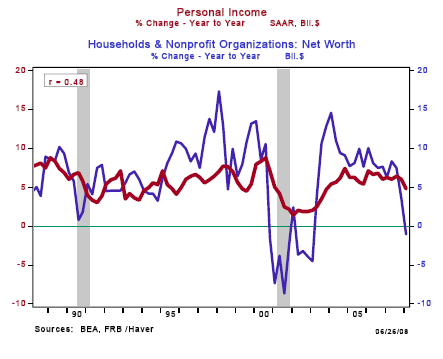
Endnotes
1. The trend lines for personal income and household net worth are calculated as a 12-quarter centered moving average of the quarterly data for the respective series. This is not the only nor the most sophisticated way to compute a long-term trend, but it suffices for our discussion.
2. Over the 20-year period from 1998:Q2 to 2008:Q1, quarterly year-over-year growth averaged 5.60 percent for net worth and 5.33 percent for nominal personal income. However, the standard deviation of the quarterly year-over-year growth rates is 6.30 percent for net worth and 1.99 percent for nominal personal income.
For additional review:
“Recent Changes in U.S. Family Finances: Evidence from the 1998 and 2001 Survey of Consumer Finances.” 2003. Board of Governors of the Federal Reserve System Federal Reserve Bulletin vol. 89, no. 1, Jan. 2003, pp. 1-32.
“Survey Shows Increased Income and Net Worth for U.S. Families.” 2003. Federal Reserve Bank of Atlanta Financial Update vol. 16, no. 2, 2003: Q2.